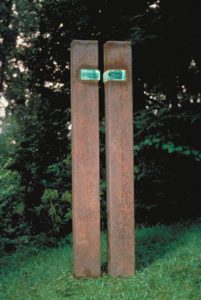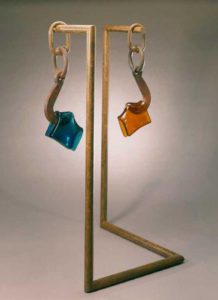John Perreault, New York Art Critic, poet, painter, former contributing editor for the Village Voice.


Mary Shaffer’s work is sculpture. But this does not say quite enough in the terms of its unique location within the scheme of things. Although she has been exhibiting her work since 1975 in a gallery primarily devoted to painting and noncraft sculpture (O.K. Harris in New York), she has also shown in glass-specific or craft venues (the Heller Gallery in New York and Anne O’Brian Gallery in Washington, DC). Shaffer belongs to two worlds and is not made uncomfortable by this seeming paradox. Although her works are clearly not vessels, she shares with vesselmakers and other glass artists the difficulties-and pleasures-of working with a material that some consider automatically seductive. What other material captures light so wondrously? What other material can you look into as well as through?
Too seductive, I can imagine any number of my art critic colleagues muttering. One also hears from glass artists themselves. Particularly glassblowers, that glass is instant satisfaction: no nightlong vigils at the kiln; no applications of glazes that look nothing like what they will become; pure light; pure color. It is all done with heat and air-and the judicious use of centrifugal force and gravity. The reality is quite different: hot, nerve-wracking, physically demanding.
And is glass really that seductive? Perhaps at first glance. But in opposition to its shine and bright colors are such qualities as coldness, hardness, and glitz. Furthermore, any beauty that is automatic does not stay beautiful for long. Beauty without thought or function is superficial. Even decoration must have complexity and meaning in order not to pall.
Shaffer does not come to glass sculpture from a crafts context but from painting. Her continuing emphasis on the vertical plane reflects this; also, it was in painting that she first attempted to find expression for her fascination with windows and light. Dissatisfied, she began constructing installations and tried her hand at more conceptual forms. It was not until she found glass itself or it found her that she came into her own. This act of fate or happenstance is in retrospect not entirely mysterious. She was at that time in close contact with the developments in the glass art at the Rhode Island School of Design where Dale Chihuly was head of the glass department. At one point Fritz Dreisbach was living in her basement studio and it was he who suggested slumped glass. Although she went on to produce installations and environment pieces that did not use glass, she was hooked as it were.
The time was the early 70s. Process Art offered a new attitude towards materials. The exhibition Anti-illusion: Procedures/materials had already been presented at the Whitney Museum in New York in 1969. Artists such as Richard Serra (rubber, lead, neon), Eva Hesse (tubing, fiberglass, fiber, latex), Robert Morris (felt), and Rafael Ferrer (ice, dead leaves) were exploring non-art materials, and letting the materials themselves, or rather their physical properties or qualities, dictate composition. It was the period of spreading, hanging, leaning, slumping (!) art. Not only was this new kind of art fully covered in the art magazines, artists such as Italo Scanga (who sometimes works in glass) taught at the lively Rhode Island School of Design campus. Marcia Tucker, one of the curators of the Anti-illusion exhibition, taught several semesters of contemporary art there as well.
Shaffer, particularly attracted to glass in its molten state, began to make works that froze or stopped the glass at a certain points during the heating process. Window glass was positioned on various armatures that then became part of the piece: wire, nails, coat-hangers and finally the grids of ready made concrete reinforcing steel mesh. Chance, timing, and gravity, then as now, were her prime tools. Her approach has been consistently experimental. She has produced works in nonlinear clusters organized around particular process such as controlled breakage; others are identified as hanging, standing, bundled and off-edge. Her glass installations of a few years ago were threateningly beautiful. In my view she is an important artist and innovator who has still not received the recognition she deserves.
But what is innovation? Meaningful innovation in art cannot be guaranteed by rules, but novelty can. Merely doing the reverse of what everyone else seems to be doing or doing it bigger or more consistently (without doing it better) will only result in temporary surprise. Following an attitude or device to its logical conclusion or to an extreme might be more productive, but this too does not make the result automatically significant or aesthetic. Similarly, new materials or combinations of materials will not do in themselves, nor will previously tried combinations of styles, composition, media, process, or subjects. All of these devices may be of enormous inspiration for the artist, but none will work towards aesthetic ends, if the timing is off and the basic talent–so impossible to define–is missing. Talent is facility; it seems not to have to do with will power (though discipline may be necessary), but it certainly has something to do with luck, another mystery.
Two other formula come to mind. The first is the employment of information not possessed or understood by colleagues or competitors, the way Marcel Duchamp seized upon the obscure “poetic” devices of the eccentric Raymond Roussel; the second is the rarest of all and involves starting from original first principals in the manner of Buckminster Fuller or a John Cage. Here also the results seem to depend on who, what, where, when, and why. The storage vaults and dumps of art are full of novel works that were not meaningful innovations. Art is simply too complicated a matter involving too many variables to be strictly a rational enterprise.
I am rehearsing these thoughts in order to provide a context for a body of glass art that I consider truly innovative on both the formal and aesthetic planes. According to the schemata outlines above, Shaffer’s work fits into the penultimate formulae or rule examined-that of possessing or understanding information in advance of colleagues, This, as in most cases, can only now be determined by hindsight. More importantly it leaves a great deal to be explained. Being first affords a novelty effect, but first is not always best. Her sculptures are not mere novelties any more than Harvey Littleton’s or-in non-glass sculpture-David Smith’s or Eva Hesse’s are.
At a time when artists working in glass-a great many of them coming out of a crafts background-yearn to have the fruits of their labor or their cleverness accepted as full-fledged art, it may be instructive to examine some of the rules of the game and the imponderables they yield. I have been focusing on innovation because it is the one value that, from a traditional point of view, is seen to be what separates the two areas of visual production. Novelty, now that many craftsworkers have turned their back on production ware (or are calling it something else in imitations of nonutilitarian art), is a plague on both our houses. Quality is the Zen koan that applies across the board, but continues to elude rational discourse as it becomes synonymous with authority.
Shaffer began by applying the anti-form, anti-illusion principles of art-making that were being explored in the art world to what was then almost an exclusively crafts material. Thus she accomplished what might be viewed as a double transplant or simultaneous hybridization: she brought “art” to glass and glass to “art.” That Italo Scanga, as she herself admits, had already produced some pieces using hot glass (melted glass from a furnace) over various tools, is neither here nor there. She developed slumping (using plate glass in a kiln) into a full-blown vocabulary.
Here I think we have come upon the key: and ability to compound a series of innovations into a language that permits a consistent unfolding of expression. Unless we are supremely blessed with intuition, this is a quality that can only be determined over time. Shaffer’s time has come. After a setback caused by a studio fire in Rhode Island and the difficulties of resettling in the Washington, DC area-she still uses a factory space in Queens, NY-Shaffer has gone through a process of refocus and is back to work as a full time artist.
Shaffer’s recent exhibition at the Anne O’Brien Gallery in Washington consists of two kinds of work. Spectacular slumped glass and chromated steel-grid wall pieces using full blown and flattened colored glass given to her by Harvey Littleton-and thus titled the Lit Series-add another layer of complexity to her signature format. On the other hand, the glass and cast metal constructions in the Inversion Series mark a new direction.
Referring back to her 1979 installation Just the two of us at the University of Rhode Island Fine Arts Gallery which featured (in addition to sound, smell, and light) photographs of paired objects, the present work juxtaposes nearly identical forms, one glass with metal, one metal with glass. The two parts to each piece are odd mirror images of each other. In one, light seems to pour through an obstacle, while its mate, it is darkness that pours through the openings. These are maquettes for pieces that if executed will be at least eleven feet in height.
Shaffer is now moving in the direction of public art. Her new wall pieces-Wind-Wall and Cast-Air-have been commissioned by the Oliver T. Carr Company and will soon be completed in the lobby of their Washington, DC building. The first of these wall-sized “glass-murals” uses slumped and cut glass, the other presents patterns formed by thousands of trapped air-bubbles.
Shaffer-ever the experimenter-is proceeding to develop new areas of her glass language. As we struggle to keep up with her, the depth of her vision becomes more and more apparent. Although her works are surely about glass-as-glass, there is a metaphysical level as well: light, gravity, and pairing are symbolic. Innovation alone, no matter how daring, does not guarantee that conjunction of process, form, and meaning that is the central mystery of art. Shaffer, more often than not, continues to produce that miraculous conjunction.